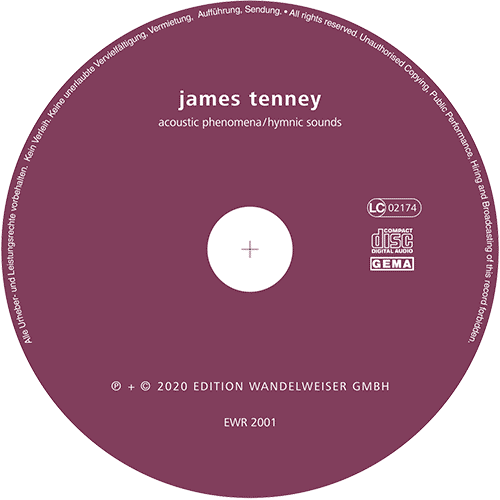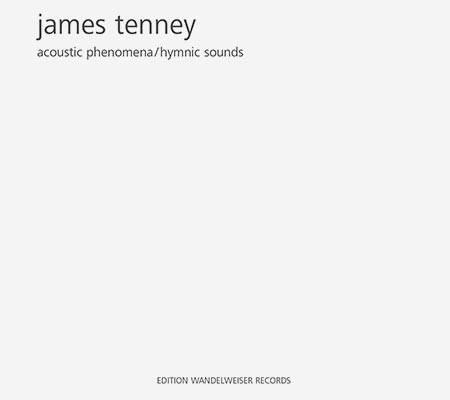EDITION WANDELWEISER RECORDS
> CD catalogue
>> james tenny
_____________________________________________________________________
<< >>
james tenney
acoustic phenomena / hymnic sounds
| order reference: medium: composer: performer: |
EWR 2001 CD james tenney ensemble OPEN MUSIC Gera |
 |
 |
| james tenney: acoustic phenomena / hymnic sounds 1 harmonium # 2 - for lou harrison (1976) 2 ritical band for any 16 or more sustaining instruments (1988/2000) 3 bonus track: burkhard schlothauer accidental microtonals sounds - together (2019) ensemble OPEN MUSIC Gera: andreas nordheim (slide trumpet), elena kakaliagou (french horn), hilary jeffery (trombone), rishin singh (trombone), robin hayward (tuba), peer salden (alto clarinet), burkhard schlothauer (musical director, violin), david hummel (violin), ullrich phillipp (double bass), alan torres (church organ samples) audio excerpt: ► critical band (17:01) in an interview in 2002 james tenney explained to me that, in his opinion, the subject of tuning systems should be added to the musical fields of innovation named by john cage: sound/noise, consonance/dissonance, sound/silence, organisation of time. he gave me the score of critical band, in which he had changed by hand the size of the ensemble from 10 to 16 instruments. later, we (the ensemble zeitkratzer) rehearsed the works on this cd for three weeks one hour each day, so we could learn to hear and play the different intervals with confidence. doing this was a revelation to me opening up the rich field of microtonality. in the compositions assembled on this cd, as in many others, tenney uses a climax-oriented, archaically simple form - tenney called this form "swell piece". however, the position of the dynamic climax varies: critical band (1988/2000) reaches the greatest number of notes, the greatest expansion (compass of 8 notes including octave doublings) and the greatest volume only in the last bar; in harmonium #2 (1976) it is located approximately in the middle (5 tones). in both works also each tone increases and decreases, increasing and decreasing being about equally long. in harmonium #2, every tone should last between 4 and 12 seconds and is followed by a pause of at least the same length. the musicians may choose their tones from the tonal material of the respective segment. critical band begins at concert pitch A - in a performance this evolves from the tuning process - and adds very distant harmonic partials to it, which are located so closely to the A, that the ear perceives them as beatings. ‚critical band‘ is a term from psychoacoustics indicating a frequency range in which the ear combines excitations into a partial sensation. in the last segment the work ends upon a completely natural seventh chord over A = 110 hz, with partials 1 to 8 - all frequencies are integer multiples of the fundamental frequency. harmonium #2 introduces a widely spaced just major chord over an existing fundamental, and then immediately lowers the just major third by more than a semitone. this produces a natural seventh, by which the previous fundamental A is reinterpreted as a fifth to the fundamental D, which is added later. this is followed by the fifth partial (major third) of D resulting in a complete chord of harmonic overtones, with D as its fundamental. this process is repeated adding some more partials and leads through G to a hexachord on C including partials 7, 11 and 17. then the fundamental changes upward to F without preparation, while the tones previously soun- ding above C continue to sound - this results in strong dissonances (F4 to E5 - 14cents; F4 to F#6 - 49cents and a too low fourth F4-Bflat4 -31), which are only gradually transformed into tones partials of fundamental F. a further upward change of the fundamental leads to B (in the cadence it would be B flat) and the tones of the F chord are all reinterpreted immediately through microtonal changes to the chord tones of B7. the final triad with a natural seventh upon E is theoretically the dominant of the opening chord - but it does not sound dissonant in any way. tenney's undogmatic, humorous and flexible theoretical and practical handling of the sounds from the harmonic series and its combination with psychoacoustics and traditional theory of harmony in my eyes makes these two works so admirable. |